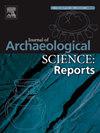Association between biological kinship and lifestyle in the Hellenistic-early Roman community of Menainon, Sicily
IF 1.5
2区 历史学
0 ARCHAEOLOGY
引用次数: 0
Abstract
In the Greco-Roman society, the household (oikos or domus) was the central socio-economic unit, and its members were likely to have shared the same space, similar food and economic activities. Given the importance of biological kinship as a factor determining household membership, this paper explores the extent to which individuals from Hellenistic-early Roman Menainon (Sicily) who were likely biological relatives also shared a similar lifestyle (e.g., diet, mechanical and physiological stress). Biodistances (pairwise Gower coefficients) were used as a proxy for biological kinship and were estimated using dental metric and nonmetric traits on a sample of 98 individuals. The results did not support our initial hypothesis that individuals biologically related shared a similar lifestyle. Instead, a very limited association was found between biodistances and other skeletal markers, but also between biodistances and the spatial arrangement of the cemetery. This is not an unexpected finding since biological kinship was only one of the many factors determining household membership in the Greco-Roman world. Moreover, it is clear from historical sources that household members may have shared several daily experiences but they also held distinct roles, which would affect their dietary patterns, physiological and mechanical stress levels. Finally, Menainon was a rural settlement, where community members likely shared comparable burdens on an everyday basis, as also attested by previous bioarchaeological studies. Future analyses need to incorporate currently unavailable aspects of the material culture from the cemetery in conjunction with the skeletal evidence in order to explore kinship from a biosocial perspective.
西西里岛梅奈农希腊化-罗马早期社区的生物亲缘关系与生活方式之间的联系
在希腊罗马社会,家庭(oikos 或 domus)是社会经济的核心单位,其成员很可能共享相同的空间、相似的食物和经济活动。鉴于生物亲缘关系是决定家庭成员的一个重要因素,本文探讨了希腊化时期-罗马早期梅奈农(西西里岛)中可能是生物亲缘关系的个体在多大程度上共享相似的生活方式(如饮食、机械和生理压力)。生物间距(成对高尔系数)被用作生物亲缘关系的替代指标,并通过对 98 个样本的牙齿度量和非度量特征进行估算。结果并不支持我们最初的假设,即有生物亲缘关系的个体有着相似的生活方式。相反,我们发现生物间距与其他骨骼标志物之间的关联非常有限,而且生物间距与墓地空间布局之间的关联也非常有限。这并不是一个意料之外的发现,因为在古希腊罗马世界,生物亲缘关系只是决定家庭成员的众多因素之一。此外,从历史资料中可以清楚地看出,家庭成员可能有一些共同的日常经历,但他们也扮演着不同的角色,这将影响他们的饮食模式、生理和机械压力水平。最后,梅奈农是一个农村定居点,社区成员很可能每天都要分担类似的负担,这一点也得到了以前的生物考古学研究的证实。未来的分析需要将墓地中目前尚未发现的物质文化方面与骨骼证据结合起来,以便从生物社会的角度探讨亲属关系。
本文章由计算机程序翻译,如有差异,请以英文原文为准。
求助全文
约1分钟内获得全文
求助全文
来源期刊

Journal of Archaeological Science-Reports
ARCHAEOLOGY-
CiteScore
3.10
自引率
12.50%
发文量
405
期刊介绍:
Journal of Archaeological Science: Reports is aimed at archaeologists and scientists engaged with the application of scientific techniques and methodologies to all areas of archaeology. The journal focuses on the results of the application of scientific methods to archaeological problems and debates. It will provide a forum for reviews and scientific debate of issues in scientific archaeology and their impact in the wider subject. Journal of Archaeological Science: Reports will publish papers of excellent archaeological science, with regional or wider interest. This will include case studies, reviews and short papers where an established scientific technique sheds light on archaeological questions and debates.
 求助内容:
求助内容: 应助结果提醒方式:
应助结果提醒方式:


